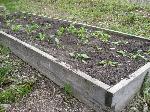BLUE SPRINGS, Mo. — An ideal soil is half solid and half pore space by volume, and that pore space should be equal parts air and water. Gardening practices greatly influence pore space in cultivated soils.
“Most gardeners don’t have an ideal soil, particularly as it relates to pore space,” said Marlin Bates, University of Missouri Extension horticulturist.
“We need soils to hang on to an appropriate amount of water while maintaining empty pore space for soil aeration,” Bates said.
In poorly drained soils, water occupies most if not all pores after a rainfall or irrigation. “This leads to plant stress by reducing microbial activity and root function,” he said. “In addition, since poorly drained soils can quickly become saturated at the surface, they are often subjected to runoff and erosion.”
Well-drained soils, on the other hand, not only allow for percolation of more water, which reduces runoff and erosion, they also leave empty pore space after infiltration, which leads to better plant growth.
But soils can also be too well-drained. “The issue here is reduced soil structure—the arrangement of soil particles into aggregates—or lack of organic matter,” Bates said.
These soils often can be found where substitute soil has been brought in. “For instance, many raised beds are filled with a soil and compost mixture that has been pulverized,” he said. “With little to no soil structure to bind water in these beds, gardeners are constantly irrigating their gardens because they dry out very quickly.”
You can perform a percolation test to determine where your soil lies on the drainage spectrum, Bates said.
Simply dig a hole 12 inches deep, even on the sides and level on the bottom. Fill the hole with water and let it sit for one hour to soak the soil. Refill the hole with water and note the rate at which the water level falls over the next few hours.
“An ideal percolation rate is 2 inches per hour,” Bates said. If the water drains at an average rate of more than 4 inches per hour, it is too well-drained. If it drains less than 1 inch per hour, the soil is poorly drained.
“Interestingly, the best way to deal with either scenario is to increase organic matter,” he said. Additional organic matter can both increase infiltration of poorly drained soils and reduce high infiltration of soils that are too well-drained. How you apply that organic matter may differ depending on the situation.
“For poorly drained soils, cover crops may be the best way to improve percolation,” he said. Fibrous-rooted grains like winter wheat or rye will develop root systems that navigate through heavy soils, opening up channels for percolation when the roots die down.
“It is important to understand that this benefit will only be realized if the cover crop is not tilled into the garden, but left undisturbed under the soil surface,” he added. This approach may take a few cover cropping seasons to improve drainage. For new garden areas with poorly drained soils, some gardeners install subsurface drainage systems to help with water percolation.
For soils that are too well-drained, adding bulk organic matter to the soil will increase its water-holding capacity and slow percolation by enhancing structure and microorganism populations.
“By incorporating this amendment into the profile of the soil after applications, gardeners will realize the benefits very quickly,” Bates said.
In gardens with well-drained soil, maintain it by preserving soil structure. “Limit or eliminate the frequency with which the tiller enters the garden and refrain from any activity that compacts the soil, especially when the soil is wet,” Bates said.
For more information from MU Extension about gardening topics, including publications, websites and events, go to www.extension.missouri.edu and click on the “Lawn and garden” link.
Read more http://extension.missouri.edu/news/DisplayStory.aspx?N=1397





